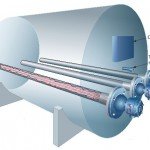 A Heater Control Panel includes components to control the heater, sensors to protect the heater, and pilot devices for operator control. Other sensors are used for automatic operation.
A Heater Control Panel includes components to control the heater, sensors to protect the heater, and pilot devices for operator control. Other sensors are used for automatic operation.
Industrial applications require heat to improve the efficiency of handling process fluids; liquids, gases, dry solids, and slurry mixtures, and to provide freeze protection.
- keep fluids from solidifying
- reduce the time for ingredients to combine
- cook something
- keep something from freezing
Heater Controls
Protecting the heater is a priority because a failure can have serious consequences. At a minimum you don’t want the heater to overheat and start a fire. A Heater Control Panel has to know the status of process variables required to control and protect the heater. This means it has to connect to devices that are monitoring the process.
- Pressure – Protect the vessel
- Temperature – Control the heater and protect the vessel
- Level – Insure there’s fluid to keep the heaters immersed

The Heater Control Panel has to be able to control a single or multiple heaters depending on the vessel / heater configuration as follows.
- Start and Stop heaters based on the following
- Remote Run / Permissive signal, or
- Product Temperature, or
- Heating Timer
- Control heaters using the following
- Fixed heater output – Use a contactor or Solid State Relay
- Variable heater output – Use multiple contactors or a Solid State Power Controller
The Heater Control Panel has to give an Operator the ability to turn the power on and off, control the process, and monitor the process and the status of all alarms as needed.
- Power
- Main Power Disconnect
- Control
- Hand-Off-Auto Selector, and if used
- Product Temperature Setpoint
- Heating Timer Setpoint
- Monitor / Display
- Running Status light,
- Alarm Status lights, and if used
- Product Temperature
- Heating Timer
